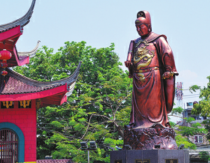Peace, partnership and prosperity: Zheng He's legacy remembered

Admiral Zheng He's legacy is as vast as the oceans he once sailed in.
This year marks the 618th anniversary of the 15th-century Chinese explorer and diplomat's historic voyages, and his legacy is celebrated around the world for its profound impact on diplomacy, trade and cultural exchanges.
From 1405 to 1433, Zheng He embarked on seven epic voyages and commanded a fleet that consisted of colossal treasure ships, some of which were more than 100 meters long, a scale unrivaled in the world at that time, according to studies.
The fleet, manned by about 30,000 sailors, reached distant shores as far as Southeast Asia, South Asia, the Middle East, and even East Africa. He set off nearly a century before Christopher Columbus set foot in America.
The grand tour began on July 11, 1405, and this date has been dubbed China's Maritime Day.
"Zheng He led his fleet on peaceful missions, and he treated sovereigns of other lands with the utmost respect," Zhao Zhigang, the deputy secretary-general of the China Zheng He Research Association and a senior adviser of the International Zheng He Society in Singapore, told China Daily.
"That's a world away from the plundering that Western mariners engaged in."
In August, Indonesia held events to commemorate the admiral's arrival in Semarang city in Central Java Province. At Sam Poo Kong temple, devotees held a procession parading the explorer's statue.
Moreover, Semarang's name in Chinese — sanbaolong — originated from Zheng He's original name, Sanbao, illustrating the city's deep historical connection to the navigator.
Veronika Saraswati, a China relations expert at the Jakarta-based think tank Centre for Strategic and International Studies, said Zheng He's expeditions were not merely trade missions.
"Zheng He arrived in Semarang, Central Java, for the purpose of trade, but ended up staying for much more. … He began by spreading a new agriculture system and moved on to people-to-people exchanges like culture and language," she told China Global Television Network.
"China's and Indonesia's cultures are now intertwined for generations to come and this is something that cannot be separated because we see both countries have similar values and cultures within the Asian region."
Apart from being an explorer, Zheng He also engaged in diplomacy, a testament to China's peaceful engagement with other countries.
Gesture of goodwill
Sri Lanka, then known as Ceylon, was an important stop during Zheng He's maritime odyssey. He and his crew members communicated with locals, traded goods and presented steles as a gesture of goodwill.
The Zheng He Galle Stele, dated 1409, was discovered in Galle, Sri Lanka, in 1911 and is now preserved in the Colombo National Museum. It is a stone tablet with an inscription in three languages, Chinese, Tamil and Persian. A rubbing of the stele was presented as a state gift to China in 2014.
Samitha Hettige, an expert on strategic studies and conflict prevention, told Xinhua News Agency that the concept of the Maritime Silk Road has a deep historical basis dating back to Zheng He's expeditions.
"The Maritime Silk Road is a network that will connect products and services across the globe," he said.
Among the places that the admiral had visited, Malacca remains the epitome of Zheng He's influence on cultural exchanges between the East and the West. The Malaysian city, which he visited five times during his seven voyages, houses a gallery and a cultural museum in his name.
In January, the Sixth Zheng He Forum was held in Kuala Lumpur to discuss the explorer's indelible marks on civilization.
"Zheng He's voyages in the Malay Archipelago and their momentous impact on civilization are a reminder of Malaysia's foreign policy outlook," Malaysian Foreign Minister Zambry Abdul Kadir told the forum.
In his three decades of voyages, Zheng He led his fleet to more than 30 countries and conducted trade with the locals.
He also presented gifts of gold, silver, porcelain and silk to monarchs on foreign lands. In return, he brought back to China precious stones and exotic animals, including a giraffe.
"Court officials were shocked to see the giraffe. They had never seen such a long-necked animal," Zhao said. "From then on, painters began giving animals longer necks."
Pan Jie in Beijing and Xinhua contributed to this story.
shaoxinying@chinadaily.com.cn
























